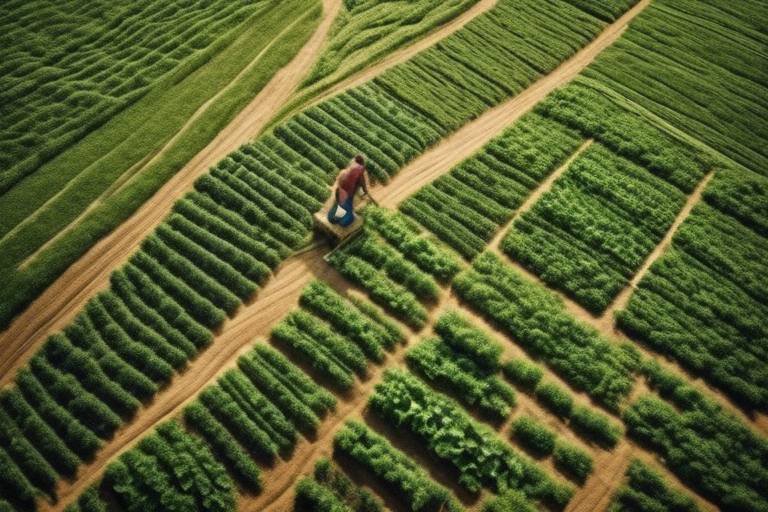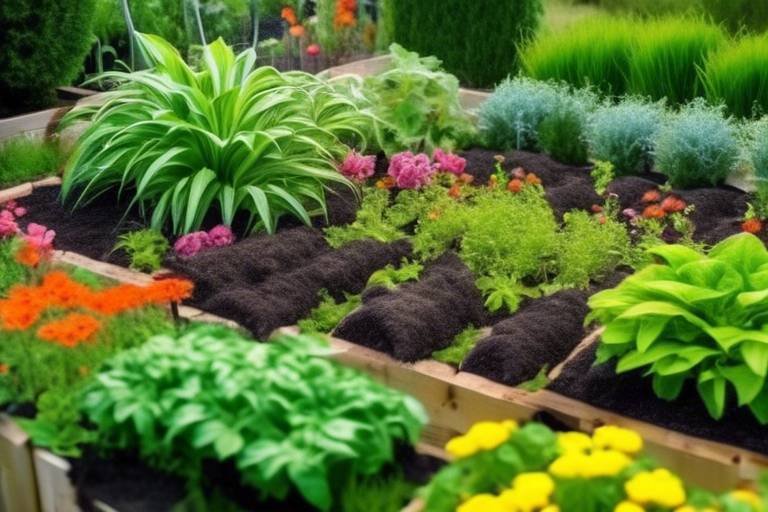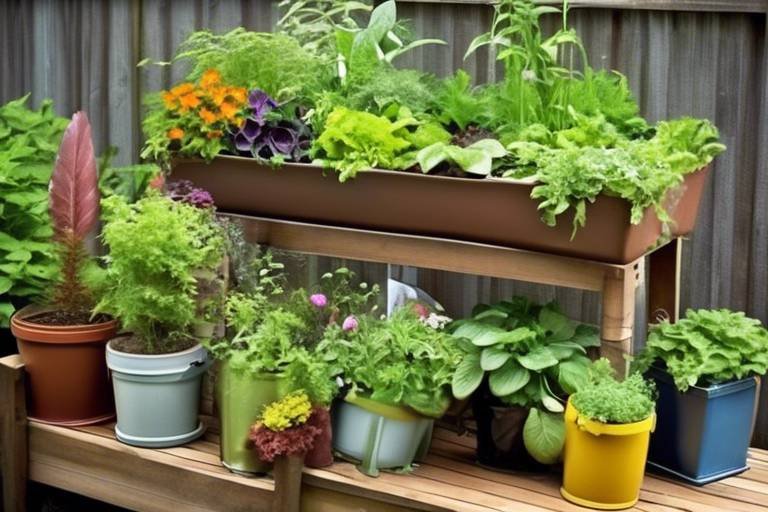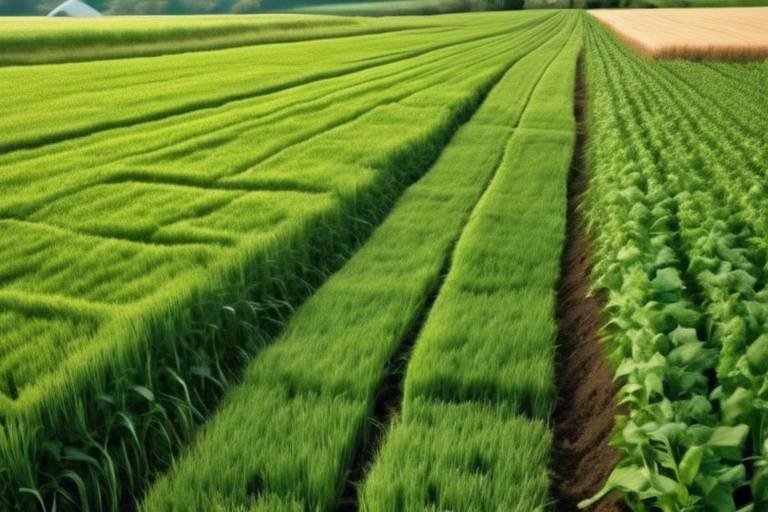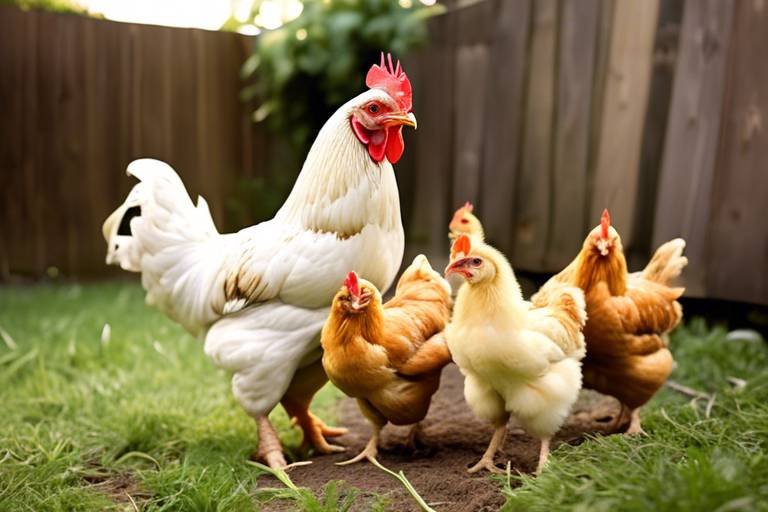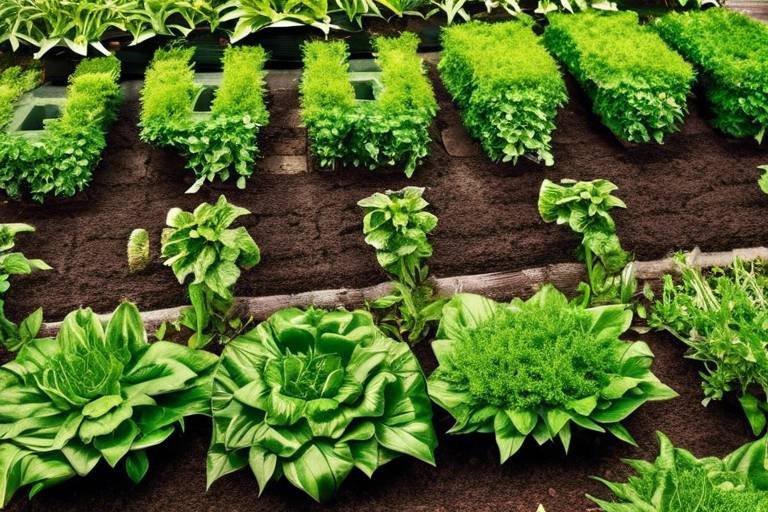Eco-Friendly Farming Practices that Enhance Soil Health
Welcome to the world of eco-friendly farming, where the health of our soil is not just a priority, but a necessity! In a time when environmental concerns are at the forefront of global discussions, it's essential to recognize that sustainable farming methods can significantly improve soil health, promote biodiversity, and reduce our overall environmental impact. But what does it really mean to enhance soil health? Well, think of soil as the very foundation of life on Earth, much like the roots of a tree that nourish its growth. When we take care of our soil, we are essentially nurturing the entire ecosystem, ensuring that it thrives for generations to come.
In this article, we will delve into various sustainable farming practices that can lead to healthier ecosystems and more productive agricultural systems. From composting to cover cropping and crop rotation, each method plays a vital role in maintaining and enhancing soil health. So, whether you're a seasoned farmer or just starting your journey into sustainable agriculture, there's something here for everyone. Are you ready to discover the secrets to vibrant, healthy soil? Let’s dig in!
Soil health is crucial for sustainable agriculture, acting as the backbone of all farming practices. But what exactly does "soil health" encompass? It includes several key components: organic matter, microbial activity, and nutrient availability. Each of these elements works in harmony to create a thriving environment for plants, animals, and beneficial microorganisms.
Organic matter is like the lifeblood of soil; it improves soil structure, enhances moisture retention, and provides essential nutrients as it decomposes. Microbial activity, on the other hand, is akin to a bustling city within the soil, where countless organisms work tirelessly to break down organic materials and release nutrients. Finally, nutrient availability ensures that plants have access to the essential elements they need to grow strong and healthy. Without a balanced combination of these components, soil can become degraded, leading to poor crop yields and a less resilient ecosystem.
One of the most effective methods to enhance soil health is through composting. This process involves recycling organic waste into nutrient-rich soil amendments, creating a win-win situation for both the environment and your garden. Imagine transforming kitchen scraps, yard waste, and other organic materials into a powerful fertilizer that can rejuvenate your soil!
The benefits of composting are numerous:
- Improved soil structure: Compost helps to create a crumbly texture, allowing for better aeration and drainage.
- Enhanced fertility: It provides a slow-release source of nutrients that plants can use over time.
- Reduced waste: Composting diverts organic materials from landfills, reducing greenhouse gas emissions.
Different composting methods cater to various needs and scales of farming. Here’s a quick look at some popular types:
| Type of Composting | Description | Advantages |
|---|---|---|
| Hot Composting | Accelerates decomposition through high temperatures. | Quick production of nutrient-rich compost. |
| Cold Composting | Slower process, allowing materials to decompose naturally. | Less labor-intensive and requires minimal management. |
| Vermicomposting | Utilizes earthworms to break down organic material. | Produces high-quality compost and improves soil structure. |
Hot composting is an efficient method that accelerates the decomposition process by generating high temperatures. This method requires a careful balance of green materials (like kitchen scraps and grass clippings) and brown materials (such as dried leaves and cardboard). The result? Quick, nutrient-rich compost that can be ready in just a few weeks!
On the other hand, vermicomposting is like having a tiny army of earthworms working for you. These little critters break down organic material and produce castings that are incredibly beneficial for soil health. Setting up a vermicomposting system is easy and can be done in small spaces, making it perfect for urban gardeners.
Proper application of compost is vital for maximizing its benefits. It's not just about throwing it on the ground; it requires technique! Incorporating compost into the soil can enhance fertility and structure effectively. You can spread it on the surface, mix it into the topsoil, or even create compost tea for a nutrient-rich liquid feed. The key is to ensure that the compost is well-distributed and interacts with the soil, allowing plants to access those nutrients.
Another sustainable practice that significantly improves soil health is cover cropping. This technique involves planting specific crops during the off-season to prevent erosion, enhance soil structure, and promote biodiversity. Cover crops act like a protective blanket over the soil, shielding it from harsh weather conditions and helping to maintain moisture levels.
By using cover crops, farmers can also suppress weeds and improve nutrient cycling. Some popular cover crops include clover, rye, and vetch, each offering unique benefits to the soil. But how do you choose the right cover crops for your needs? Let's explore that next!
Selecting appropriate cover crops is essential for achieving desired soil health outcomes. Factors to consider include:
- Climate: Different cover crops thrive in different climates.
- Soil Type: Some crops are better suited for sandy soils, while others prefer clay.
- Specific Benefits: Determine what you want to achieve, such as nitrogen fixation or erosion control.
Crop rotation is another fundamental practice that helps maintain soil fertility and prevent pest buildup. By rotating different crops in a systematic manner, farmers can disrupt the life cycles of pests and diseases, leading to healthier plants and improved yields. It’s like giving your soil a break, allowing it to recharge and rejuvenate.
Creating an effective crop rotation plan involves strategic planning and a bit of foresight. Think of it as a puzzle where each piece must fit perfectly to maximize soil health and crop yields while minimizing disease risks. Consider factors such as crop family, nutrient needs, and growth cycles when designing your rotation schedule. The goal is to create a balanced system that promotes biodiversity and enhances soil vitality.
Q: What is the best way to improve soil health?
A: The best way to improve soil health is through a combination of practices such as composting, cover cropping, and crop rotation. Each method contributes to building a rich, fertile soil ecosystem.
Q: How long does it take for compost to be ready?
A: Depending on the method, compost can take anywhere from a few weeks (hot composting) to several months (cold composting) to fully decompose and be ready for application.
Q: Can I use cover crops in small gardens?
A: Absolutely! Cover crops can be used in small gardens to prevent erosion and improve soil health, making them beneficial regardless of the size of your farming operation.

Understanding Soil Health
Soil health is an essential pillar of sustainable agriculture, acting as the foundation for healthy crops and resilient ecosystems. When we talk about soil health, we're not just referring to the dirt beneath our feet; we're discussing a complex, living entity that plays a crucial role in our food systems. Think of soil as a bustling city, teeming with life, where various organisms interact to create a thriving environment. Key components of soil health include organic matter, microbial activity, and nutrient availability. Each of these elements contributes significantly to the overall vitality of the soil.
First off, let's delve into organic matter. This is the decomposed material from plants and animals that enriches the soil. It acts like a sponge, holding moisture and nutrients, which is vital for crop growth. Without sufficient organic matter, soil can become compacted and lose its ability to support plants. Imagine trying to grow a garden in a dry, cracked surface—it's nearly impossible! That's why maintaining a healthy level of organic matter is crucial for sustainable farming.
Next, we have microbial activity. The soil is home to billions of microorganisms, including bacteria, fungi, and protozoa. These tiny organisms are the unsung heroes of soil health, breaking down organic materials and releasing nutrients that plants can absorb. They also help with the formation of soil structure, which improves aeration and water infiltration. In a way, they’re like the city workers who keep everything running smoothly, ensuring that nutrients are available when crops need them most.
Lastly, nutrient availability is another critical aspect of soil health. Nutrients such as nitrogen, phosphorus, and potassium are essential for plant growth. However, if these nutrients are not present in the right amounts or are locked away in the soil, plants will struggle to thrive. Therefore, farmers need to regularly test their soil and amend it with organic fertilizers or compost to maintain optimal nutrient levels. It’s akin to a balanced diet; just as we need a variety of nutrients to stay healthy, plants require a well-rounded supply of essential elements to flourish.
To sum it up, understanding soil health is about recognizing the intricate relationships between organic matter, microbial life, and nutrient availability. By nurturing this living system, farmers can promote biodiversity, enhance crop yields, and create a more sustainable agricultural landscape. As we explore eco-friendly farming practices, remember that the health of our soil directly influences the health of our planet. So, let’s dig deep and cultivate our understanding of this vital resource!

Composting Benefits
Composting is not just a trendy buzzword; it’s a transformative practice that can revolutionize the way we think about waste and soil health. By recycling organic materials—such as kitchen scraps, yard waste, and even paper products—into rich compost, farmers and gardeners can significantly enhance their soil's vitality. One of the most compelling benefits of composting is its ability to improve soil structure. When you add compost to your soil, it increases its aeration and drainage, creating a looser, more crumbly texture that allows roots to grow deeper and access nutrients more efficiently. Imagine your soil as a sponge; the more porous it is, the better it can absorb water and nutrients, leading to healthier plants.
Moreover, compost is a powerhouse of nutrients. It is rich in essential elements like nitrogen, phosphorus, and potassium, which are vital for plant growth. By incorporating compost into your farming practices, you not only reduce the need for chemical fertilizers but also promote a more sustainable approach to agriculture. This shift can lead to long-term benefits for both the environment and your wallet. Think about it: by creating your own compost, you are effectively turning waste into wealth!
Another significant advantage of composting is its role in reducing waste. In a world where landfills are overflowing, composting offers a practical solution to mitigate this problem. By diverting organic waste from landfills, we can minimize greenhouse gas emissions, particularly methane—a potent greenhouse gas that contributes to climate change. Not only does composting help the planet, but it also fosters a sense of community and responsibility. When you compost, you’re part of a larger movement towards sustainability and environmental stewardship.
Let’s not forget about the biodiversity that composting encourages. Healthy soil is teeming with life, from beneficial bacteria to earthworms, all of which play a crucial role in maintaining soil fertility. By adding compost, you’re essentially feeding these organisms, promoting a thriving ecosystem right beneath your feet. This biodiversity not only helps in nutrient cycling but also improves the soil's resilience against pests and diseases, creating a self-sustaining agricultural system.
In summary, the benefits of composting are multifaceted and far-reaching. Here’s a quick recap of the key advantages:
- Improves soil structure for better aeration and drainage.
- Enhances nutrient availability, reducing the need for chemical fertilizers.
- Reduces waste and minimizes landfill contributions.
- Encourages biodiversity in the soil ecosystem.
By embracing composting, we not only enhance the health of our soils but also contribute to a more sustainable future. So, why not start composting today? It’s a simple step that can lead to profound changes in your farming practices and the environment!

Types of Composting
When it comes to composting, one size definitely does not fit all. There are various methods tailored to meet different needs and scales of farming, each with its own unique processes and benefits. Understanding these types of composting can help you choose the right one for your agricultural practices, ultimately enhancing soil health and sustainability.
Let's delve into some of the most popular composting methods:
- Hot Composting: This method is all about speed and efficiency. Hot composting uses high temperatures to accelerate the decomposition process. By maintaining a temperature between 130°F and 160°F (54°C to 71°C), you can break down organic materials quickly, producing compost in as little as 4 to 6 weeks. The heat generated not only speeds up decomposition but also kills off pathogens and weed seeds, making it a powerful tool for farmers looking to create nutrient-rich compost rapidly.
- Cold Composting: If you’re looking for a more laid-back approach, cold composting might be your best bet. This method involves layering organic materials and letting them decompose naturally over time. While it takes longer—typically several months to a year—the process is less labor-intensive. You simply pile up your organic waste and let nature do its thing. Cold composting is perfect for those who prefer a hands-off approach and have the patience to wait for the compost to mature.
- Vermicomposting: Have you ever thought about using worms to help you compost? Vermicomposting does just that! This method employs red wigglers (earthworms) to break down organic materials into rich, dark compost known as worm castings. Not only is it a fantastic way to recycle kitchen scraps, but it also produces a nutrient-dense product that can significantly enhance soil health. Setting up a vermicomposting system is relatively easy and can be done indoors or outdoors, making it accessible for everyone.
Each of these composting methods has its own set of advantages and can be tailored to fit specific needs. For instance, hot composting is ideal for those who want quick results and have adequate space and materials to manage high temperatures. Cold composting, on the other hand, is perfect for gardeners who prefer a low-maintenance approach. Vermicomposting is an excellent option for urban dwellers or anyone looking to compost indoors.
In summary, the type of composting you choose should align with your goals, available resources, and the scale of your farming operation. Whether you opt for the rapid results of hot composting, the simplicity of cold composting, or the unique benefits of vermicomposting, each method contributes to healthier soil and a more sustainable farming practice. So, which method resonates with you? Remember, the journey to better soil health starts with the right composting choice!

Hot Composting
Hot composting is a dynamic and efficient method of recycling organic waste into a nutrient-rich soil amendment. This technique takes advantage of the natural process of decomposition by creating conditions that promote high temperatures, typically between 130°F to 160°F (54°C to 71°C). These elevated temperatures are crucial because they accelerate the breakdown of materials, kill off pathogens and weed seeds, and ultimately yield compost in a fraction of the time compared to traditional composting methods.
To effectively implement hot composting, you'll need to gather a variety of organic materials, which can be broadly categorized into two types: browns and greens. Browns include carbon-rich materials like dry leaves, straw, and cardboard, while greens consist of nitrogen-rich items such as kitchen scraps, grass clippings, and fresh plant trimmings. A balanced mix of these materials is essential for achieving the necessary heat and ensuring a successful composting process.
Here's a quick overview of the materials needed for hot composting:
| Material Type | Examples | Purpose |
|---|---|---|
| Browns | Dry leaves, straw, cardboard | Provide carbon |
| Greens | Kitchen scraps, grass clippings | Provide nitrogen |
| Water | Moisture | Supports microbial activity |
Once you have your materials sorted, it's time to build your compost pile. Aim for a size of at least 3 feet by 3 feet (1 meter by 1 meter) to ensure it retains heat effectively. Layer your browns and greens, and don't forget to add some water to keep the pile moist but not soggy. Turning the pile every few weeks will introduce oxygen, which is vital for the aerobic bacteria that break down the organic matter.
The benefits of hot composting are manifold. Not only does it produce compost quickly, but it also creates a more uniform product, which can be easily applied to gardens and fields. The high temperatures achieved during the process help eliminate pathogens and weed seeds, making your compost safer and more effective for enhancing soil health. Additionally, the rapid decomposition process means you can enjoy the fruits of your labor sooner, enriching your soil with vital nutrients and organic matter.
In conclusion, hot composting is an excellent choice for anyone looking to improve soil health while efficiently managing organic waste. By understanding the balance of materials, maintaining the right conditions, and turning the pile regularly, you can create a robust compost that supports vibrant plant growth and a thriving ecosystem.
- What is the ideal temperature for hot composting? The ideal temperature range is between 130°F to 160°F (54°C to 71°C).
- How long does it take to produce compost using hot composting? Hot composting can produce finished compost in as little as 2 to 3 months, depending on the conditions and materials used.
- Can I use meat and dairy products in hot composting? It's generally advised to avoid meat and dairy due to the risk of attracting pests and creating odors.
- How often should I turn the compost pile? Turning the pile every 2 to 4 weeks is recommended to maintain aeration and temperature.

Vermicomposting
Vermicomposting is an innovative and eco-friendly method of composting that harnesses the natural processes of earthworms to break down organic materials. This method is not just efficient; it’s also a fantastic way to enrich soil health. Imagine turning your kitchen scraps into a goldmine for your garden—this is the magic of vermicomposting! By using specific types of worms, primarily the red wiggler, this process can transform organic waste into nutrient-rich compost known as worm castings. These castings are packed with essential nutrients and beneficial microorganisms that can significantly enhance soil fertility.
Setting up a vermicomposting system is surprisingly simple and can be done in various scales, from a small bin in your kitchen to larger setups in backyards. To get started, you’ll need a suitable container, bedding material like shredded newspaper or cardboard, and, of course, the worms themselves. The bedding not only provides a habitat for the worms but also helps to maintain moisture levels in the bin. Once you have your setup ready, simply add your organic waste, such as fruit and vegetable scraps, coffee grounds, and eggshells. The worms will do the rest, munching away and converting waste into valuable compost.
One of the standout benefits of vermicomposting is its ability to improve soil structure. The worm castings produced are rich in humus, which helps retain moisture and improves aeration in the soil. This means that your plants will have access to nutrients more efficiently, leading to healthier growth. Additionally, the microbial activity stimulated by earthworms can help suppress soil-borne diseases, making your garden more resilient. In essence, vermicomposting is like giving your garden a nutrient boost while also reducing the amount of waste sent to landfills.
For those wondering about the maintenance of a vermicomposting system, it’s relatively low-effort. Regularly check the moisture levels, ensuring that the bedding remains damp but not soggy. You can harvest the worm castings every few months by separating the worms from the compost, which can be done by moving the finished compost to one side of the bin and adding fresh bedding and food to the other. The worms will migrate to the new food source, allowing you to collect the rich compost easily.
In conclusion, vermicomposting is not just a sustainable practice; it’s a rewarding one. By engaging in this method, you’re not only reducing waste but also contributing to a healthier ecosystem. It’s a win-win situation for both you and the environment, making it a practice worth considering for anyone interested in enhancing soil health.
Q: What types of worms are best for vermicomposting?
A: The most commonly used worms for vermicomposting are red wigglers (Eisenia fetida) due to their voracious appetite and ability to thrive in composting environments.
Q: Can I use meat or dairy products in my vermicomposting system?
A: It’s best to avoid adding meat, dairy, and oily foods to your vermicomposting bin, as these can attract pests and create odors. Stick to fruit and vegetable scraps, coffee grounds, and eggshells.
Q: How often should I feed my worms?
A: You can feed your worms every few days, depending on the size of your worm population and the amount of organic waste you produce. Monitor their activity and adjust feeding accordingly.
Q: How do I know when my vermicompost is ready?
A: Your vermicompost is ready when it appears dark, crumbly, and has a rich earthy smell. It typically takes about 2-3 months for the worms to process the organic material into compost.

Application of Compost
When it comes to enhancing soil health, the is a game-changer. Think of compost as a magic potion for your garden or farm—it's packed with nutrients that can rejuvenate tired soil, improve its structure, and promote a thriving ecosystem. But how do you ensure that you're applying compost effectively? The answer lies in understanding the best practices for its incorporation.
First and foremost, it’s essential to know the right timing for application. Generally, compost can be applied at two crucial times: before planting and during the growing season. If you apply compost before planting, it allows the nutrients to integrate into the soil, enriching it right from the start. On the other hand, adding compost during the growing season can provide a nutrient boost to your plants when they need it the most.
Now, let’s talk about how to actually apply compost. Here are some effective techniques:
- Top Dressing: This method involves spreading a layer of compost on the soil surface around your plants. It's an excellent way to add nutrients without disturbing the soil structure.
- Tilling: For larger areas, you can mix compost into the top few inches of soil using a tiller. This method helps to improve soil aeration and moisture retention.
- Compost Tea: This liquid fertilizer is made by steeping compost in water. It can be sprayed directly onto plants or used to water them, providing a quick nutrient boost.
But wait, there’s more! The quantity of compost you apply is just as important as the method. A general rule of thumb is to apply about 1 to 3 inches of compost to your garden beds. Too much compost can lead to nutrient overload, which can harm your plants. It's like giving your garden too much of a good thing—balance is key!
Another important aspect to consider is the quality of compost. Not all compost is created equal. High-quality compost should be dark, crumbly, and have an earthy smell. If your compost has a foul odor or is too lumpy, it may not provide the benefits you’re looking for. Always opt for well-aged compost, as it is more stable and less likely to compete with plants for nutrients.
Lastly, keep in mind that composting is not a one-time event. Regular application of compost can lead to long-term improvements in soil health. Think of it as a relationship—the more you nurture it, the better it will grow! By incorporating compost into your soil management practices, you are not only enhancing its fertility but also contributing to a more sustainable farming system.
Q1: How often should I apply compost to my garden?
A1: It’s best to apply compost at least once a year, ideally in the spring before planting or in the fall after the harvest.
Q2: Can I use compost on all types of plants?
A2: Yes, compost is beneficial for most plants, but always check specific plant needs, as some may require more or less nutrient input.
Q3: Is it possible to over-apply compost?
A3: Yes, applying too much compost can lead to nutrient imbalance and plant stress. Stick to the recommended amounts for best results.
Q4: What should I do if my compost smells bad?
A4: A foul smell usually indicates that the compost is not aerated properly or has too much nitrogen. Turn your compost pile to aerate it and balance the carbon-to-nitrogen ratio.

Cover Cropping
Cover cropping is an incredibly effective and sustainable agricultural practice that plays a vital role in enhancing soil health. By planting specific crops during the off-season, farmers can significantly improve the quality of their soil, prevent erosion, and promote biodiversity. Imagine your soil as a sponge; when it's well-maintained with cover crops, it can absorb water more efficiently, retain nutrients, and support a thriving ecosystem beneath the surface. Isn't that a fascinating thought?
One of the primary benefits of cover cropping is its ability to prevent soil erosion. When fields are left bare, they become susceptible to the forces of nature, such as wind and rain, which can wash away precious topsoil. By planting cover crops, farmers create a protective layer that holds the soil in place, much like a blanket keeping you warm on a chilly night. This not only protects the soil but also enhances its structure, making it more resilient to weather extremes.
Moreover, cover crops contribute to the overall health of the soil by improving its organic matter content. As these crops grow and eventually decompose, they add vital nutrients back into the soil. This process is akin to nature's way of recycling, where the life cycle of plants helps sustain and enrich the earth. Additionally, cover crops can suppress weeds, reducing the need for chemical herbicides, which aligns perfectly with eco-friendly farming practices.
When selecting cover crops, it's essential to consider various factors such as climate, soil type, and the specific benefits you wish to achieve. For instance, legumes like clover and vetch are fantastic for fixing nitrogen in the soil, while grasses like rye can help with soil structure and erosion control. Each type of cover crop serves a unique purpose, and understanding these differences can lead to better decisions for your farming practices.
Incorporating cover crops into your farming strategy is not just about improving soil health; it's also about fostering a diverse ecosystem. Cover crops can attract beneficial insects and pollinators, creating a balanced environment that supports various forms of life. This biodiversity is crucial for maintaining a healthy agricultural system and can lead to increased resilience against pests and diseases.
To sum it up, cover cropping is a multifaceted approach that enhances soil health, promotes biodiversity, and reduces environmental impact. By embracing this practice, farmers can cultivate not only their crops but also a healthier planet for future generations. So, why not give it a try? The benefits are not just for the soil; they extend to the entire ecosystem, making it a win-win situation for everyone involved.
- What are cover crops? Cover crops are plants grown primarily to improve soil health and prevent erosion during off-seasons.
- How do cover crops help with soil erosion? They create a protective layer on the soil, which helps to hold it in place and prevent washing away by rain or wind.
- Can cover crops improve soil fertility? Yes, as they decompose, they add organic matter and nutrients back into the soil, enhancing its fertility.
- What types of cover crops should I use? It depends on your specific goals, climate, and soil type. Legumes are great for nitrogen fixation, while grasses help with soil structure.

Choosing the Right Cover Crops
When it comes to , it’s essential to consider several factors that can significantly impact your farming success. Think of cover crops as the superheroes of your soil—they protect, nourish, and rejuvenate it while you’re not actively growing your main crops. But just like how every superhero has their unique powers, each type of cover crop offers distinct benefits depending on your goals and local conditions.
First and foremost, you need to evaluate your climate. Different cover crops thrive in various weather conditions. For instance, if you live in a region with harsh winters, you might want to consider winter rye or hairy vetch, which can withstand cold temperatures and provide excellent ground cover. Conversely, if you’re in a warmer climate, legumes like crimson clover or cowpeas can flourish and contribute nitrogen back into the soil.
Next, consider your soil type. Sandy soils may benefit from cover crops that have deep root systems, such as daikon radish, which can help break up compacted layers and improve water infiltration. On the other hand, clay soils might require cover crops that enhance soil structure and drainage, such as buckwheat or oats.
Another vital aspect to think about is the specific benefits you want to achieve with your cover crops. Are you looking to suppress weeds, enhance soil fertility, or improve biodiversity? For example, if weed suppression is your primary goal, a dense planting of barley can outcompete unwanted plants. If you aim to boost soil nutrients, legumes are your best bet since they can fix atmospheric nitrogen, enriching the soil for future crops.
To help you visualize the options, here’s a simple comparison table that outlines some popular cover crops and their benefits:
| Cover Crop | Benefits | Best For |
|---|---|---|
| Winter Rye | Soil erosion control, weed suppression | Cold climates |
| Hairy Vetch | Nitrogen fixation, soil structure improvement | Moderate to cool climates |
| Crimson Clover | Nitrogen fixation, attractive to pollinators | Warm climates |
| Daikon Radish | Soil compaction alleviation, deep rooting | All climates |
| Buckwheat | Weed suppression, attracts beneficial insects | Warm seasons |
Ultimately, the key to successful cover cropping lies in understanding your specific farming objectives and adapting your choices accordingly. It’s a bit like assembling a team of superheroes; you want a diverse set of powers to tackle various challenges. By taking the time to choose the right cover crops, you can create a thriving ecosystem that not only supports your current crops but also lays the groundwork for a sustainable future.
- What are cover crops? Cover crops are plants grown primarily to improve soil health and prevent erosion during off-seasons.
- How do cover crops benefit soil health? They enhance soil structure, increase organic matter, suppress weeds, and can fix nitrogen.
- Can I use cover crops in my vegetable garden? Absolutely! Cover crops can be beneficial in vegetable gardens, especially during the off-season.
- How do I incorporate cover crops into my farming practice? You can plant cover crops after harvesting your main crops and till them into the soil before planting your next crop.

Crop Rotation Techniques
Crop rotation is more than just a farming practice; it's a strategic approach to maintaining soil health and fertility. By alternating the types of crops grown in a specific area across seasons or years, farmers can prevent soil depletion, reduce pest and disease cycles, and ultimately enhance productivity. Think of it as a dance between different crops, where each partner plays a vital role in keeping the soil vibrant and rich.
One of the key principles of crop rotation is understanding the nutrient needs of different plants. For instance, legumes, such as peas and beans, have the unique ability to fix nitrogen in the soil, enriching it for subsequent crops. On the other hand, heavy feeders like corn and tomatoes draw significant nutrients from the soil, which can lead to depletion if planted in the same spot year after year. By rotating these crops, farmers can create a balanced nutrient profile in the soil, ensuring that it remains fertile and productive.
Additionally, crop rotation helps to disrupt the life cycles of pests and diseases. Many pests and pathogens are crop-specific, meaning they thrive when their preferred host is continuously planted. By rotating crops, farmers can significantly reduce the incidence of these pests, minimizing the need for chemical pesticides. This not only promotes a healthier ecosystem but also contributes to the sustainability of farming practices.
To design an effective crop rotation plan, consider the following factors:
- Crop Family: Group crops by their botanical families to ensure diversity. For example, alternate between legumes, brassicas (like cabbage and broccoli), and root vegetables.
- Nutrient Needs: Plan rotations based on the nutrient requirements of the crops. Follow heavy feeders with nitrogen-fixing crops to replenish soil health.
- Pest and Disease Resistance: Monitor pest patterns and rotate to crops that are less susceptible to the same pests.
- Soil Type and Climate: Tailor your rotation to suit the specific soil and climatic conditions of your farm.
Here's a simple table illustrating a sample crop rotation plan:
| Year | Crop 1 | Crop 2 | Crop 3 |
|---|---|---|---|
| 1 | Corn | Beans | Squash |
| 2 | Potatoes | Cabbage | Carrots |
| 3 | Wheat | Peas | Sunflowers |
Creating a crop rotation plan requires thoughtful consideration and a bit of trial and error, but the benefits are well worth the effort. Not only does it help maintain soil health, but it also leads to increased yields and decreased reliance on synthetic fertilizers and pesticides. In essence, crop rotation is a sustainable farming practice that encourages a harmonious relationship between the soil, crops, and the environment.
1. What is crop rotation?
Crop rotation is the practice of growing different types of crops in the same area across seasons or years to improve soil health, reduce pest and disease cycles, and enhance productivity.
2. How does crop rotation improve soil health?
By alternating crops, farmers can maintain a balanced nutrient profile, prevent soil depletion, and disrupt pest life cycles. This leads to healthier soil and more robust crops.
3. Can crop rotation reduce the need for pesticides?
Yes! By rotating crops, farmers can minimize the occurrence of pests that thrive on specific crops, reducing the need for chemical pesticides and promoting a healthier ecosystem.
4. How do I create a crop rotation plan?
Consider factors such as crop family, nutrient needs, pest resistance, and your specific soil type and climate. A well-planned rotation schedule can significantly enhance soil health and crop yields.

Designing a Crop Rotation Plan
Creating an effective crop rotation plan is like crafting a recipe for success in farming. It requires careful thought, a pinch of creativity, and a dash of knowledge about your land and crops. The primary goal of crop rotation is to maintain soil fertility, reduce pest and disease pressure, and enhance biodiversity. But how do you go about designing a plan that works for you? Let’s dive into the essential steps and considerations.
First and foremost, you need to understand your soil. Each plot of land has its own unique characteristics, such as pH levels, nutrient content, and moisture retention capabilities. Conducting a soil test can provide you with valuable insights into what your soil needs. This information will guide you in selecting crops that not only thrive in your soil but also contribute to its health when rotated. For example, legumes like peas and beans are fantastic for fixing nitrogen in the soil, which benefits subsequent crops like corn or tomatoes.
Next, consider the growth habits and nutritional needs of the crops you plan to grow. Grouping crops with similar requirements can simplify your rotation schedule. For instance, you might want to follow heavy feeders like corn with light feeders such as cucumbers. This practice helps to balance nutrient uptake and prevent soil depletion. Additionally, incorporating a variety of crops will disrupt pest cycles. For example, if you plant brassicas (like cabbage) one year, follow them with a completely different family, such as nightshades (like peppers), the next year. This rotation can significantly reduce pest populations that thrive on specific crops.
Another critical aspect of designing your crop rotation plan is timing. Crop rotation is not just about what you plant; it’s also about when you plant it. You should consider the growing seasons of your crops. Some crops, like winter wheat, can be planted in the fall, while others, like summer squash, are best suited for spring planting. By staggering your planting times, you can maximize the use of your land and ensure that your fields are productive throughout the year. This approach also helps in managing soil moisture and reducing erosion.
To visualize your crop rotation plan, it can be helpful to create a rotation schedule. A simple table can be a great tool for this. Here’s a basic example:
| Year | Crop 1 | Crop 2 | Crop 3 |
|---|---|---|---|
| Year 1 | Corn | Beans | Squash |
| Year 2 | Potatoes | Cabbage | Carrots |
| Year 3 | Wheat | Peas | Tomatoes |
This table helps you visualize what crops will be planted each year, ensuring that you adhere to your rotation principles. Remember, flexibility is key! Nature can be unpredictable, so be prepared to adjust your plan based on weather conditions or pest outbreaks.
Lastly, always keep track of what works and what doesn’t. Maintaining a journal of your crop rotation practices can provide insights into what combinations yield the best results. This record will be invaluable for future planning and can help you refine your strategy over time.
In conclusion, designing a crop rotation plan is a dynamic process that requires attention to detail, understanding of your soil, and knowledge of crop relationships. By investing time in creating a thoughtful rotation plan, you’re not just enhancing your soil health; you’re paving the way for a more sustainable and productive farming future.
- What is the main purpose of crop rotation? Crop rotation aims to maintain soil fertility, reduce pest and disease pressure, and promote biodiversity.
- How often should I rotate my crops? It’s generally recommended to rotate crops annually, but the frequency can depend on the specific crops and local conditions.
- Can I plant cover crops in my rotation? Absolutely! Cover crops can be integrated into your rotation to improve soil health and prevent erosion.
- What are some common mistakes in crop rotation? Common mistakes include not considering soil health, failing to track crop performance, and planting the same crop family consecutively.
Frequently Asked Questions
- What is soil health and why is it important?
Soil health refers to the condition of soil in terms of its ability to function as a living ecosystem. It is crucial because healthy soil supports plant growth, regulates water, and helps to sequester carbon, thereby playing a significant role in combating climate change.
- How does composting benefit soil health?
Composting enriches soil by adding organic matter, improving soil structure, and enhancing nutrient availability. It also helps retain moisture and promotes microbial activity, which are essential for healthy plant growth.
- What are the different types of composting?
There are several composting methods, including hot composting, cold composting, and vermicomposting. Each method has its own process and benefits, catering to different needs and scales of farming.
- How do I apply compost effectively?
To maximize the benefits of compost, it should be evenly incorporated into the soil. Techniques include top-dressing, mixing it into the planting hole, or using it as a mulch to enhance soil fertility and structure.
- What are cover crops and how do they improve soil health?
Cover crops are plants grown primarily to improve soil health rather than for harvest. They prevent erosion, enhance biodiversity, and can even fix nitrogen in the soil, leading to improved fertility and structure.
- How do I choose the right cover crops for my farm?
Selecting the right cover crops depends on various factors such as climate, soil type, and the specific benefits you want to achieve. Consider your farming goals, and choose crops that will thrive in your conditions.
- What is crop rotation and why is it beneficial?
Crop rotation is the practice of growing different crops in a specific sequence on the same land. This technique helps maintain soil fertility, reduces pest buildup, and can lead to healthier crops overall.
- How can I design an effective crop rotation plan?
To design a crop rotation plan, consider factors such as crop families, nutrient needs, and pest cycles. A well-thought-out rotation schedule can maximize soil health and yields while minimizing risks of disease.




